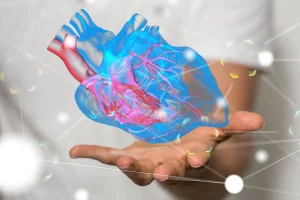 The knee is a very complex mechanism and we need to take care of it. Though strong, over time, using the knee improperly can do serious damage that can lead to other problems in the body and even result in the need for surgery on the knee itself. There is a lot going on in the workings of the knee in a relatively small area.
The knee is a very complex mechanism and we need to take care of it. Though strong, over time, using the knee improperly can do serious damage that can lead to other problems in the body and even result in the need for surgery on the knee itself. There is a lot going on in the workings of the knee in a relatively small area.
Locking out (commonly called hyperextension) puts all of your weight into your heels and causes over stretching in the ligaments behind the knee and puts enormous pressure on the front, or Patella. Hyperextension also causes or exacerbates weakness in the Quadriceps muscles and thus makes the knee very unstable. The cumulative effect wears away the cartilage and possible tearing of ligaments.
Locking the knees can also cause heel and shin pain because of the uneven weight placed upon them.
Hyperextension in standing
When standing it is very important to balance your weight between your heels and toes, keep your core engaged, spine stacked and neck elongated. This can be exhausting. Which is why, if you tend to stand for long periods of time, you might find yourself settling your weight into the rear of the pelvis and then into the heels. This will usually cause the knees to lock because they have to. Otherwise you’d fall backwards.
Hyperextension in exercise
I see this a lot in my Pilates practice. Some people are more prone to hyperextension than others but all are able to do it. A common cue in Pilates is to micro bend the knees (this is also true for the elbow as well), which helps alleviate hyperextension. I repeat this cue hundreds of times per week.
When exercising there is a tendency to think more force is better. So people will sometimes press hard into their heels to extend the leg, which visually looks like a pop or a bounce at the knee. This causes just as much damage as lingering on a hyper extended knee. In doing any kind of leg exercises focus on extending the leg from the top down instead of the foot up. Another common cue in Pilates is to extend the leg from the gluteus and hamstrings. I cannot repeat this cue enough.
Not only is it important to keep the knee slightly flexed, it is even more important to strengthen the muscles around the patella. If you have a habit of hyperextension you almost certainly have weak quadriceps. The lower part of the Quad muscles support the knee and make it more difficult to hyperextend or lock out. Do knee strengthening exercises like wall slides every day to build up the muscles that support the patella. As always combine strengthening with stretching.
Basic Wall Slide:
Stand with your back flat against the wall with knees bent and the front of the thighs at about a 45-degree angle. Arms can rest down by your sides. Toes, knees and hip bones are aligned facing forward and legs are hip distance apart. Slide your back down the wall until your glutes, and knees are aligned. The heels should be directly under the knees. At this stage the thighs will be parallel to the floor and you will look like you are sitting in a chair. Hold for 12-30 seconds and then slide slowly back up the wall to your starting position. Repeat 3-5 times.
As always, if you have a pinching or burning sensation in the knees, stop immediately and consult a joint specialist to rule out any pre-existing damage.
Jessica Kuiken is a Los Angeles based Pilates instructor. Follow her on Twitter and Facebook and Instagram

















